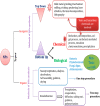Nanoparticles: Alternatives Against Drug-Resistant Pathogenic Microbes
- PMID: 27355939
- PMCID: PMC6273897
- DOI: 10.3390/molecules21070836
Nanoparticles: Alternatives Against Drug-Resistant Pathogenic Microbes
Abstract
Antimicrobial substances may be synthetic, semisynthetic, or of natural origin (i.e., from plants and animals). Antimicrobials are considered "miracle drugs" and can determine if an infected patient/animal recovers or dies. However, the misuse of antimicrobials has led to the development of multi-drug-resistant bacteria, which is one of the greatest challenges for healthcare practitioners and is a significant global threat. The major concern with the development of antimicrobial resistance is the spread of resistant organisms. The replacement of conventional antimicrobials by new technology to counteract antimicrobial resistance is ongoing. Nanotechnology-driven innovations provide hope for patients and practitioners in overcoming the problem of drug resistance. Nanomaterials have tremendous potential in both the medical and veterinary fields. Several nanostructures comprising metallic particles have been developed to counteract microbial pathogens. The effectiveness of nanoparticles (NPs) depends on the interaction between the microorganism and the NPs. The development of effective nanomaterials requires in-depth knowledge of the physicochemical properties of NPs and the biological aspects of microorganisms. However, the risks associated with using NPs in healthcare need to be addressed. The present review highlights the antimicrobial effects of various nanomaterials and their potential advantages, drawbacks, or side effects. In addition, this comprehensive information may be useful in the discovery of broad-spectrum antimicrobial drugs for use against multi-drug-resistant microbial pathogens in the near future.
Keywords: antibiotics; antimicrobial; drug resistance; medicine; metal oxide; mode of action; nanoparticles; pathogens; silver; synthesis.
Conflict of interest statement
The authors declare no conflict of interest.
Figures
References
-
- Lemke T.L., Williams D.A. Foye’s Principles of Medicinal Chemistry. Lippincott Williams and Wilkins; Baltimore, MD, USA: 2008.
Publication types
MeSH terms
Substances
LinkOut - more resources
Full Text Sources
Other Literature Sources
Medical



